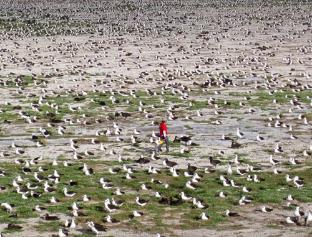Published in the Ocean Watch column, Honolulu Star-Advertiser © Susan Scott
December 27, 2010
 This holiday season I am spending in a faraway land with taskmasters who work me long hours next to strangers in beating sun, driving rain and gale-force winds. At the end of each day, I hobble back to my room and collapse in a heap, soaking wet or oversunned, blistered, filthy and exhausted.
This holiday season I am spending in a faraway land with taskmasters who work me long hours next to strangers in beating sun, driving rain and gale-force winds. At the end of each day, I hobble back to my room and collapse in a heap, soaking wet or oversunned, blistered, filthy and exhausted.
I can’t think of a better way to spend my holidays. Once again, I’m counting albatrosses on Midway.
Each year in mid-December, 16 volunteers fly to this wildlife refuge about 1,000 miles northwest of Honolulu to count albatrosses, an annual monitoring system started in 1991. U.S. Fish and Wildlife Service managers conduct the census these three weeks because albatross egg-laying is at its peak.
To count, we workers march in a systematic fashion through the seabird colony, nest marker in one hand, counter in the other, ticking off every albatross parent sitting on an egg.
Each of these nests represents a mated-for-life couple and their soon-to-be chick (hatching begins mid-January). Since the count yields between 400,000 and 500,000 nests, and the atoll also hosts an uncountable number of young albatrosses called walkers, singing and dancing their hearts out in search of mates, we’re talking 1 million to 2 million albatrosses.
Oh, and about a million black-and-white Bonin petrels that fly from sea to the atoll each dusk like a great swarm of bats. Plus clusters of curious white (aka fairy) terns hovering overhead. Add the charming Laysan ducks wading in ponds and puddles, several species of shorebirds running amid the albatrosses eating bugs, flocks of wild canaries, basking green sea turtles and snoozing Hawaiian monk seals, and this 1,450-acre land mass feels like a living, breathing Dr. Seuss story.
THIS GATHERING of Hawaii’s native marine animals would be reason enough to pay to work here (volunteers pay their own airfare), but there’s a bonus: Because these animals evolved with no land predators, they aren’t afraid of us. As a result, working on Midway is as much fun as taking a spaceship to another planet and finding that ET lives there.
The countless stories here are also as charming as ET. Last week, for instance, we found a Laysan albatross sitting in a sand nest with a fishing net wound through it. Because the net meant an entangled death to the future chick, the federal seabird biologist with us decided to remove it.
Reaching under the bird, the biologist picked up the warm, white, avocado-size egg and handed it to a (thrilled) volunteer for safekeeping. Others of us tugged on the green net, so large it destroyed the nest mound.
The confused parent stood aside through all this, watching intently as we rebuilt the damp-sand nest.
“Don’t worry,” I told her as we packed and patted. “Hands work faster than beaks for nest-making.”
After replacing the egg in the new depression, we stepped back — and got a surprise. A black-footed albatross sitting in its own nearby nest saw the bare Laysan egg, waddled over and plopped down on it. Laughing, we gently shooed this single-minded black-foot back to its own egg and watched the Laysan parent settle onto hers.
As we left, our bird was busy fixing the sides of her new nest, probably thinking, “Nice try but needs work.”
In this era of continual bad news about the world’s oceans, Midway offers some good news. Conservation efforts are working here. Marine wildlife thrives. The Pacific lives.
We counters have a very good reason for paying $2,000 each to work in this atoll over the holidays: It makes us feel we are part of something magnificent. And that’s the Christmas gift of a lifetime.